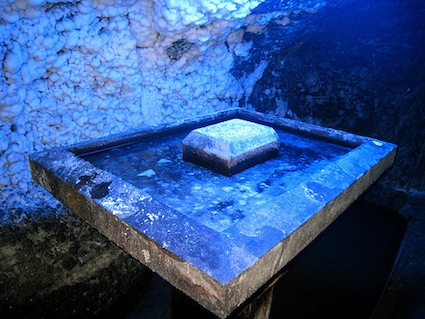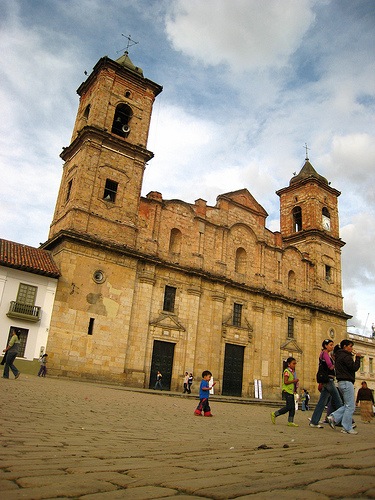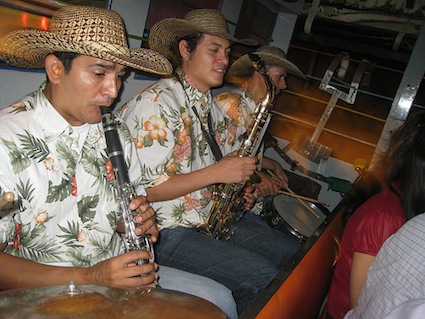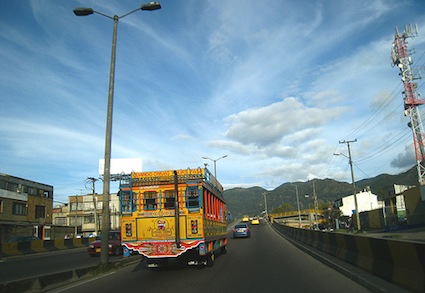The Salt Dividend
Catedral de Sal, Zipaquirá
El Dorado
Christopher Columbus never set foot in the country named after him; it was Alonso de Ojeda, one of his companions on his second voyage to the New World, who arrived at the mouth of the Orinoco River in 1499 CE. The wealth of the local Amerindians, intricate gold jewelry and stories about inland treasures drove Spanish conquest into the interior. One of the fantastic stories was about the ritual surrounding the king of the Muisca Confederate of Bacatá. The Zipa, as he was known, would float into the middle of Lake Guatavita, strip and be dusted with gold. He would offer great treasures to the sacred waters and then jump in himself. The story of El Dorado (Spanish for ‘the golden one’) told and retold with elements of many other tales became a mythical empire with mountains of gold. While the conquistadors captured riches and sent them back to the coffers of the Spanish Crown, they never found their City of Gold. In contrast to El Dorado, which has come to represent an unending quest for love, riches or happiness, is the concept of Serendipity, unexpectedly finding riches, beauty and serenity. The Englishman Horace Walpole coined the term ‘serendipity’ in 1754 in reference to the Persian fairy tale, “The Three Princes of Serendip”[1]. Serendip is the Persian name for Sri Lanka. Coming from the island nation in the Indian Ocean, I had a delightful and insightful trip to Colombia in October 2009. Serendip is a derivation of the Sanskrit term Swarnadip. The roots of this word, swarna (gold) and dvipa (island) bring us full circle to ‘the golden one’. Contrast blurs to similarity.
Gonzales Forero Square, Zipaquirá
Towards the End of War
There are many parallels between Colombia and Sri Lanka. Beyond being tropical countries with warm people, delectable cuisine and a colonial heritage, both countries are at turning points in wars that ravaged the countries for a generation or more. While the causes and the development of the conflicts differ, much can be gained from learning the historical parallels of uneven development and political intolerance leading to violent unrest.  From positions that seemed intractable, both governments of Sri Lanka and Colombia have made great progress overcoming rebel groups and reclaiming territory during the last half a decade. While the recently achieved territorial integrity is a positive starting point for social development and capitalist enterprise, lasting peace would require responses that address the underlying needs the of the people.  The governments need to be fair to all citizens, by ensuring basic freedoms for all and even access to development.
Simon Bolivar’s independence struggle resulted in the formation of Gran Colombia, which included modern-day Venezuela, Colombia, Panama and Ecuador, in 1819. Even after the separation of Venezuela and Ecuador in 1830, the centralist forces, which formed the Conservative Party, were fiercely opposed by the federalist forces, which formed the Liberal Party. A series of insurrections and civil wars between these parties culminated in the ‘War of a Thousand Days’ at the turn of the century. After a period of relative peace, differences escalated and La Violencia from 1948 to 1958 killed 300,000 people. In the aftermath, the leaders of the two parties agreed in 1956-57 to alternate four-year terms of ruling the country for the next 16 years. While this arrangement provided stability, the inability for members of alternative political parties to participate in the electoral process or become public employees effectively forced dissenting voices into the darkness of guerilla insurrection.
As the Cold War swept the world in the 1940s and 1950s, Colombia, with a colonial legacy of poor land distribution and impoverished peasants, became the perfect breeding ground for a plethora of armed leftist groups that plotted against what they deemed a self-serving and corrupt establishment. The landowners and business-cartel lords raised their own paramilitaries in response, leading to four decades of armed conflict starting from the 1960s. Leftist forces began farming and selling cocaine to support the insurrection, but as the conflict dragged on armed guerilla warfare was conducted to gain access to the cocaine trade. The Revolutionary Armed Forces of Colombia (FARC[2]), formed in 1964, was the largest of the insurgent groups, while National Liberation Army (ELN[3]) the second. Attacking civilians (especially indigenous populations) and government establishments, recruiting children, taking hostages for ransom and political leverage, and planting landmines are some of the tactics of the group. Due to these practices, FARC was branded a ‘terrorist group’ by US Department of State, Government of Canada and the European Union. Any validity to the Marxist-Leninist revolutionary ideology was lost to the cruel economics of cocaine versus human life. The right-wing paramilitaries also got into the cocaine trade in the eighties.[4] These groups formed United Self-Defense Forces of Colombia or AUC[5] in 1997.  As successive governments failed to bring vast swaths of the country under its rule[6], a generation of people grew up under guerilla rule, much like in Northern Sri Lanka.
The relative scarcity of natural resources drove northern Sri Lankans, Jaffna Tamils to diligently pursue education.   Encouraged by British colonial policy of divide and conquer that solidified ethnic identities and polarized the population[7], at the time of independence in 1948 Tamils held a disproportionately high level of government jobs from clerks to doctors and positions of tertiary-level education. With universal suffrage, ethnic Sinhala (74% of population) displaced Tamils (18% of population) from positions of power.[8] Rather than build a national consensus and counter the control structures of the colonizers, politicians used populist measures to win votes and distributed opportunity through patronage systems. A massive blow to pluralism was the majoritarian language policy ‘Sinhala Only’ act of 1956, which forced Tamils into being second-class citizens. Life-long government workers were required to pass Sinhala examinations to retain their positions and to win promotions.
Without a vibrant economy, the competition for government jobs was strong. In the 1970s, the government, having put down an armed rebellion of disenchanted Sinhala youth from the South, proposed a standardization scheme, where Tamils had to score higher to get into universities. While the eventual district quota system helped many rural students (Sinhala, Tamil and Muslim), it was at the expense of city-dwellers – the middle class Jaffna Tamils and Colombo Sinhalas. The rhetoric of a separate ‘Tamil Homeland’ was picked up by Tamil politicians for mileage.[9] Many socialist liberation movements against an unresponsive government emerged as armed groups in the North. The most ruthless of them, the Liberation Tigers of Tamil Eelam (LTTE) emerged triumphant at co-opting or destroying all other groups. LTTE’s attacks against the military lead to the 1983 anti-Tamil riots and pogroms, fueling the separatist cry. Killing all who got in their way, including premiers of two countries – Ranasinghe Premadasa of Sri Lanka and Rajiv Gandhi of India – and many prominent leaders, the LTTE came to control almost one third of the country in a pseudo-state with “taxes”, “courts” and “police”. Any and all means were justified in this ruthless war, including conscription of children, terror attacks against pilgrims at temples, planting of innumerable anti-personal landmines, kidnapping and extortion, leading to thirty-two countries proscribing them as a ‘terrorist organization’.
In today’s post-war Sri Lanka, where secessionist rebels have been militarily defeated and land they held has been retaken by the government, examining the points of contention that lead to the war will help formulate the way forward. Since the twins of Sinhala-Buddhist nationalism and Tamil nationalism grew up reinforcing each other, both have to be diffused in order to build a united nation.
Conquest versus Freedom
What the conquistadors of Colombia did not realize is that the Muisca Indians acquired their gold by trading emeralds and salt that they extracted regionally. In the Savannah of Bacatá, present elevation of 2.6km (~8,700 ft) above sea-level, salt came from the earth itself. When the Andes mountain range was forming during the Jurassic and Cretaceous periods, a saline lake evaporated all its water and the salt was trapped underground. The Muisca used water to melt small portions of the deposit and extract the valuable commodity. During the colonial era and after, progressively larger operations have mined this massive underground ore body of rock salt. Today the underground mine continues with modern mining methods, but the process flow-sheet for salt extraction is still quite similar to what it was in 5th century BCE. I took a bus from the capital Bogotá to the town named Zipaquirá – ‘the land of the Zipa’ – at the foot of the salt mountain.  In the 1930s, the miners had carved a sanctuary, to pray for protection during their work in the darkness. While a bigger cathedral for the public was built in the 1950s, it was deemed unsafe and was closed in 1992. A new Catedral de Sal (salt cathedral) was built below the old one and is one of the biggest tourist attractions around Bogotá. I got off the bus with a large ‘Zipa’ sign, without the ability to communicate in Spanish. However, a Colombian couple from the main city in the southwest called Cali, who got off the bus with me offered a ride in the cab they hired.  Colombians are proud of their beautiful country and go out of the way to be hospitable to visitors, much like their counterparts in Sri Lanka.
About 95% of Colombia’s population is Christian, and a vast majority Roman Catholic. While many cathedrals beautify the countryside, I saw no signs of state involvement in religion. The Colombian Constitution of 1991 removed Roman Catholic Church from being the state church, and expressly guarantees freedom of religion. This was a contrast to my experience landing in Colombo, Sri Lanka in August 2009. I was surprised to see a white Buddha statue before the immigration counter at the airport. While I identify as a Buddhist, along with 70% of Sri Lankans, I wonder how excluded followers of Hinduism (15% of Sri Lankans), Islam or Christianity (7.5% each) feel at the sight. Sri Lanka provides ample religious freedoms, and has a culture of tolerance and respect. However, despite the fact that Buddhist monks were accepted as advisors to the Ancient Sinhala Kingdoms, Buddhist clergy’s increasing involvement and influence in modern Sri Lankan politics does not help a polarized populace unite under a secular democracy. Stories of soldiers having to guard newly constructed Buddha statues in prominent places in the Eastern province (areas with Hindus and Muslims)[10] highlight the hegemonic nature of state intervention in religion. Buddhism was instated as the state religion in the Republican Constitution of 1972. This was another majoritarian tactic aimed at winning over the Sinhala masses, which yet again strengthened the call for a ‘Tamil nation’. Buddha statues guarded by guns do not promote peacefulness. Those long-suffering under guerilla rule need liberty, not further colonization.
What’s So Civil About War Anyway?
The 2002 election of President Ãlvaro Uribe in Colombia and Sri Lanka’s 2005 election of President Mahinda Rajapaksa were turning points for the two countries as these leaders have maintained hard-line stances on security, strengthened the military and fought back when many administrations before them let the wars fester. Both leaders have been criticized for their tactics, but both have won decisive victories. With the destruction of the top LTTE leadership, Asia’s longest civil war was declared over in May 2009[11]. While South America’s longest-running armed-conflict continues in remote areas and around the Colombian borders with Venezuela and Ecuador, most of the high population density areas are safe.[12]
Uribe may have had easier targets to attack than Rajapaksa. While FARC guerillas operated in the sparsely populated mountains away from population centers, one of LTTE’s core tactics in war was to launch mortar attacks against the army from areas with concentrations of people, for example schools and kovils (Hindu temples) full of displaced civilians. These cruel sacrifices were deemed necessary to further “the cause”, as the cry of “genocide” was used to raise funds from diaspora Tamil communities around the world. With the high-profile protest in Toronto and Tamil gang violence in London, the war in Sri Lanka has spread into the international arena. Both Colombia and Sri Lanka have to work towards dismantling the militarized society and a return to normalcy. In the Sri Lankan case, the Tamil diaspora also has a responsibility of constructive engagement, rather than continuing to push the same failed mantra of secession and polarization.[13]
Uribe has been successful at partially disarming the paramilitaries in Colombia, while under Rajapaksa, armed groups with extrajudicial powers have increased in Sri Lanka. Successive Colombian governments before Uribe had been sympathetic towards the armed groups like AUC that fought FARC. These paramilitaries are guilty of committing atrocities like killing all the children in certain villages sympathetic to FARC. However, the increasing level of accountability in Colombia is demonstrated by the ‘parapolitics scandal’, which lasted from 2006 until today. Almost 30% of the congress, including President Uribe’s cousin Mario Uribe Escobar, has been jailed for supporting AUC.
With the press under muzzle[14] and any detractors being labeled ‘traitors,’ Sri Lanka has a long way to go before realizing cleansing of such a magnitude.[15] In Sri Lanka, the breakaway faction of the LTTE that called itself Tamil Makkal Viduthalai Pulikal (TMVP) joined with the ruling party United Peoples’ Freedom Alliance (UPFA) to contest for the Eastern Province elections in May 2008. TMVP members continued to carry firearms and contestants from other parties were afraid to campaign in the East. The coalition won the elections. While the developments in the East (and now the North) have benefited those within the patronage networks, much work is needed to bring the peace dividends to the population at large, especially those most affected by decades of war.[16]
Chiva band, MedellÃn
Getting on The Fun Bus
Colombians used to travel between cities on chivas, busses with elaborately painted wooden bodies. When in MedellÃn, my hosts organized a chiva tour around town and to the botanical gardens for the visiting foreigners. We had a great time taking in the sights and enjoying Aguardiente, sugarcane alcohol, which lives up to its name – “burning water”. A band of musicians in the back-seat played popular tunes; our Colombian friends sang; the whole bus clapped along. This practice gave me flashbacks of Sri Lanka, where no group trip is complete without singing, clapping and banging on anything that would act as a drum – metal cans, plastic boxes, glass bottles or anything handy.
Both the governments of Colombia and Sri Lanka propose ‘development’ as the cure to all woes. While roads, running water and electricity will help improve quality of life the former war zones, successful plans have to ensure equal access to opportunities, and empower local institutions. In 1956 Colombia limited political expression to the Liberals and Conservatives, while around the same time, Sri Lankan politicians tried to dislodge the Tamil speaking population from the state apparatus. These exclusionary developments, followed by uneven opportunity distribution and narrow-minded nationalism lead to decades in the darkness of war. Today, both countries have golden opportunities to address the root causes of conflict with intelligent dialogue incorporating dissenting voices, rather than gloat in military victories without building political cohesion. Let us ensure that everyone can get on the fun bus, rather than leaving some by the roadside waiting to topple the next.
Chiva town, Bogotá
[1] Their highnesses, traveling in exile from their kingdom of Serendip, writes Walpole, “were always making discoveries, by accidents and sagacity, of things which they were not in quest of.”
[2] Fuerzas Armadas Revolucionarias de Colombia – Ejército del Pueblo
[3] Ejército de Liberación Nacional
[4] In 2000, the former AUC leader Carlos Castaño Gil claimed that 70% of AUC’s funding was from cocaine.
[5] Autodefensas Unidas de Colombia
[6] Estimated at 40% of total area at the peak.
[7] Pradeep Jeganathan explores Sri Lanka’s colonial past for clues to the roots of the conflict in this interview with PACT, Peace and Conflict Timetable.
[8] The census of 1989 is the best source, since war has prevented the collection of representative numbers since that time. The ‘Indian Tamil’ population (5% of the 18%), originally brought over by the British for plantation labor, never had much power, and was disenfranchised after independence.
[9] In this interview on Kafila, Ragavan, one of the founders of LTTE, provides a perceptive analysis of the development of Tamil militancy, particularly of the group he left in 1984.
[10] World Socialist Web Site, Erection of Buddha statue produces communal tensions in Sri Lanka
[11] Sri Lanka’s Ministry of Defence, LTTE defeated; Sri Lanka liberated from terror
[12] US State Department Travel Warning
[13] Dayan Jayatilleka, Tamil politics in Sri Lanka: Time to stop being suicidal
[14] BBC, Gunmen raid Sri Lanka TV station
TimesOnline, J.S. Tissainayagam, journalist lauded by Obama, is jailed in Sri Lanka
[15] British-Colombian blogger Rupert Stebbings raises the concerns of an all-out offensive – the enormous human cost of lives lost and a divided society in Sri Lanka & Colombia – Heading for the same final solution?
[16] The International Crisis Group report “Development Assistance and Conflict in Sri Lanka: Lessons from the Eastern Province” addresses the dire need for local engagement in the development process, while Kudaligama and Dissanayake address Sri Lanka’s Peace Dividends: The End of War and Beyond in the Illinois International Review.




